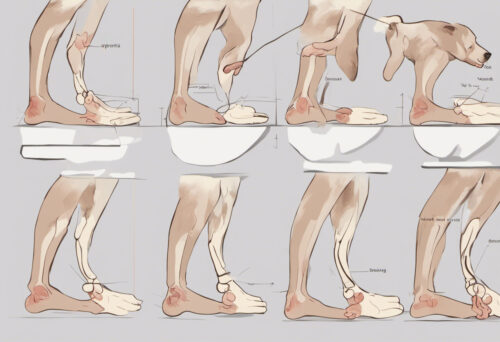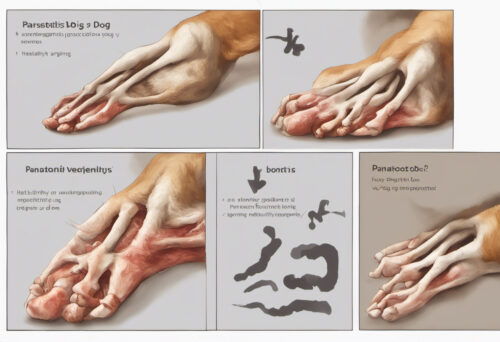Like a stalking wolf in the woods, Panosteitis might only seem dangerous for certain breeds of dogs, such as German Shepherds and Golden Retrievers. However, this common dog bone disease can affect all kinds of canines regardless of their breed, age, or size. So, let’s chew the fat on Panosteitis and, more importantly, learn how to help our furry friends if they’re ever diagnosed with it.
What is Panosteitis?
The American Kennel Club (AKC) describes Panosteitis as a form of sporadic bone inflammation that mainly affects young, growing dogs. Despite its penchant for the limbic bones, it’s one of those conditions that can move around a dog’s body and cause intermittent lameness. Surely, even just the idea of this makes every pawrent’s heart ache!
Causes of Panosteitis: A Bone to Pick with Pano
Like the mysterious fog in a Sherlock Holmes tale, the exact cause of Panosteitis still remains largely unknown within the veterinary community. Research has suggested multiple factors, such as the dog’s diet, genetics, infection, and even stress. You know your furry friend, and you know they deserve all the help we can give them. So, it’s important to note that while Panosteitis is common in larger breeds, smaller guys like Basset Hounds and Dachshunds can also be affected.
Genetics
When it comes to genetic predisposition, certain breeds such as German Shepherds and Basset Hounds seem to be more prone to Pano than other breeds.
Diet
Over-nutrition, or consuming a diet that’s too rich in protein and calories can also potentially contribute to Pano. Experts at Purina strongly advise looking closely at your pooch’s diet to ensure it’s properly balanced for their breed, weight, and age.
Signs and Symptoms: Don’t Miss the Bark(for the Trees)
PetMD highlights that this tricky ailment can manifest as a sudden onset of lameness that may seem to move from leg to leg. Besides the lameness, other signs include fever, loss of appetite, and lethargy. As these symptoms can be easily mistaken for other conditions, getting a concrete diagnosis from your vet is vital.
As all responsible and loving dog owners, it’s important that we understand the potential health risks, like Panosteitis, that could affect our furry companions. From being aware of its existence to knowing the potential signs that could indicate its presence, the more we know the better prepared we are for whatever life throws at us and our four-legged friends.

Treatment for Panosteitis: Paving Path to Positivity
How do we move forward when our furry friends are diagnosed with Pano? Thankfully, VetInfo reports that Panosteitis is usually a self-limiting disease, meaning it goes away on its own as the dog grows. While there’s no specific treatment for Pano, you can alleviate your dog’s discomfort with pain management and supportive care.
Pain Management
Don’t let Pano steal your dog’s joy. According to Today’s Veterinary Practice, administering non-steroidal anti-inflammatory drugs (NSAIDs) under professional guidance can effectively manage pain and inflammation.
Supportive Care
In addition, personal care can do wonders in complementing pain management. Ensuring your dog gets enough rest, providing comfortable bedding and offering a regulated, balanced diet can help. It’s crucial to avoid intense physical activities when your dog is experiencing a Pano flare-up.
Prevention: Better Safe Than Sorry
Given that the underlying causes are still a mystery, preventing Panosteitis is a bit like finding a needle in a haystack. However, according to a report by WSEAS, maintaining a balanced diet and avoiding over-nutrition are good starting points. It might also help avoid other health issues that might be exacerbated by poor nutrition.
Regular Check-ups
Nipping potential health issues at the bud may ensure that things never get out of the hand. Regular vet check-ups represent an excellent preventive measure to detect early signs of Panosteitis or any other health concerns. As the saying goes, “An ounce of prevention is worth a pound of cure”.
The journey through Panosteitis can be challenging but remember, all storms pass. Just being there for your dog can make a world of difference. While seeking professional help is important, nothing can replace the healing power of your love and care. After all, in their shorter, zestful lives, dogs have only one purpose – spreading unconditional love. So, in the face of Panosteitis, let’s band together to ensure their happiness always leads the way.

With every canine parent’s fear of Panosteitis, it’s essential to arm ourselves with the right strategies for tackling this disease.
Treatment of Panosteitis: Leading the Fight Against Pano
When the diagnosis is Panosteitis, things may get a bit overwhelming. But don’t fret, even though the disease might seem intimidating, it’s often self-limiting. Veterinary Practice News reports that most dogs will outgrow the disease as they mature. While Panosteitis doesn’t yet have a definitive cure, its symptoms can be managed effectively to ease your dog’s discomfort.
Pain Management
Every bark and whimper from your furry friend tears at your heartstrings, and all you yearn for is their relief. Veterinary Practice News offers hope in non-steroidal anti-inflammatory drugs (NSAIDs), which when prescribed by a vet, are very effective at controlling pain and inflammation in affected dogs.
Supportive Care
In the face of Panosteitis, your love, patience, and attentive care play a critical role in managing your pup’s discomfort. Ensuring your dog gets rest, offering comfortable bedding, and maintaining a balanced diet can go a long way. Dogs Naturally Magazine advises avoiding intense physical activities during episodes of limping or pain, to avoid exacerbating symptoms.
Prevention of Panosteitis: Laying Down the Guard
Preventing Panosteitis may sometimes feel like wrestling with a phantom due to its elusive causes. However, some best practices can promote overall health and potentially reduce your dog’s risk of developing the disease. The College of Veterinary Medicine at the University of Illinois emphasizes the importance of a balanced diet and regular veterinary check-ups.
Regular Check-ups
When it comes to our furry friends’ health, early detection can make a substantial difference. Thus, regular vet visits are essential in catching early signs of Panosteitis and nipping potential problems in the bud. The adage “prevention is better than cure” certainly holds true in this case.
While Panosteitis presents a challenge, remember, the sun always shines after the storm. Supporting your dog through this ordeal with steadfast love and care can make a world of difference. Don’t forget that professional help plays an essential role in this journey too. At the heart of everything, remember the positivity and happiness of our four-legged friends are paramount and should always illuminate our path, even when facing the cloud of Panosteitis.



